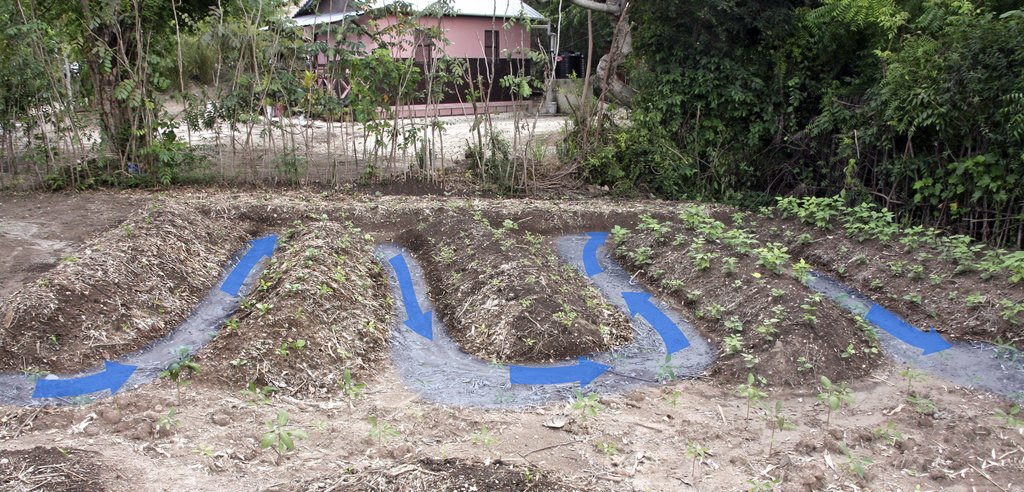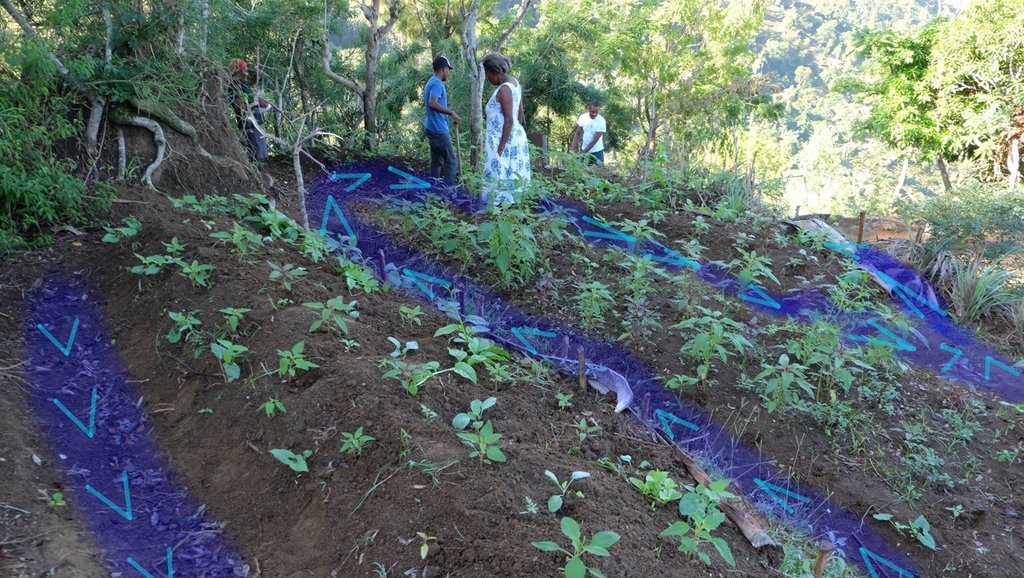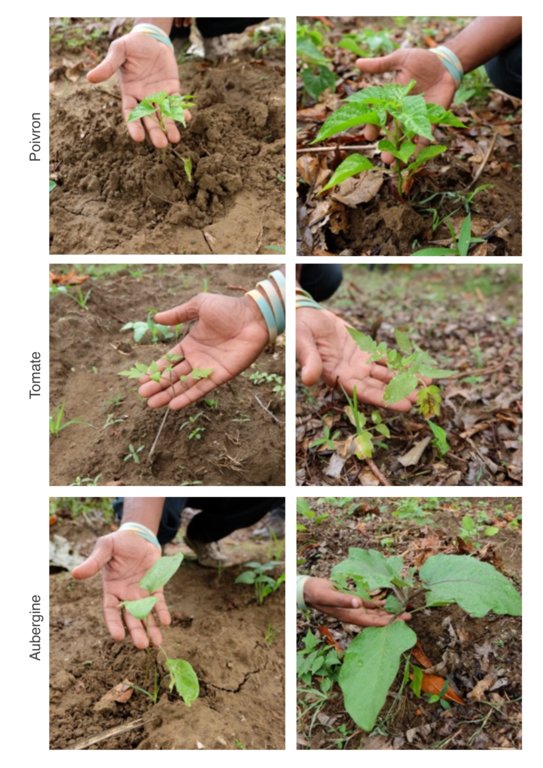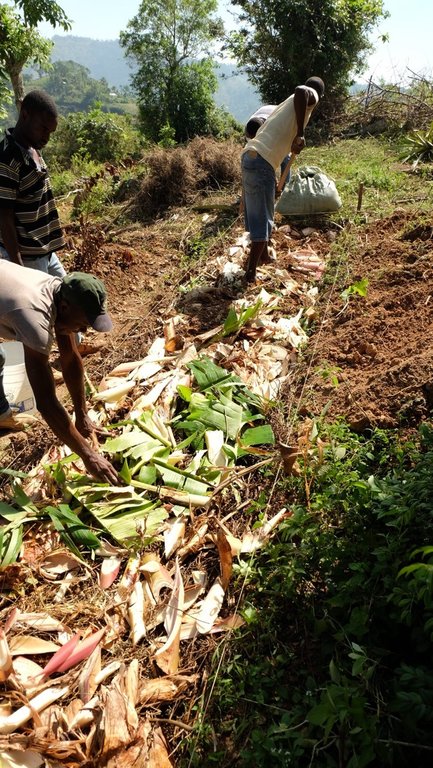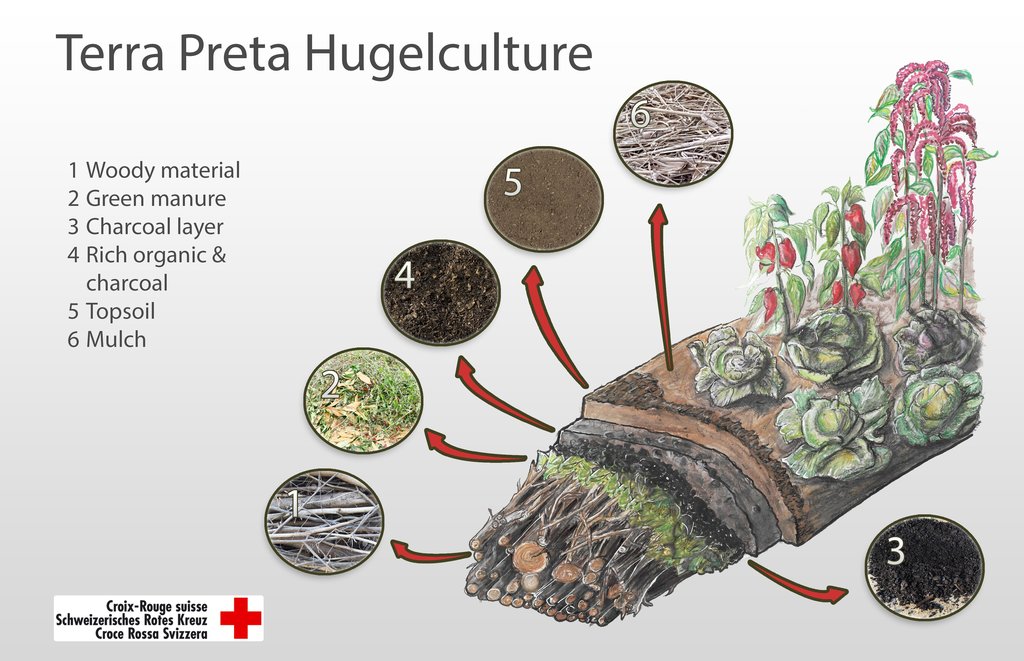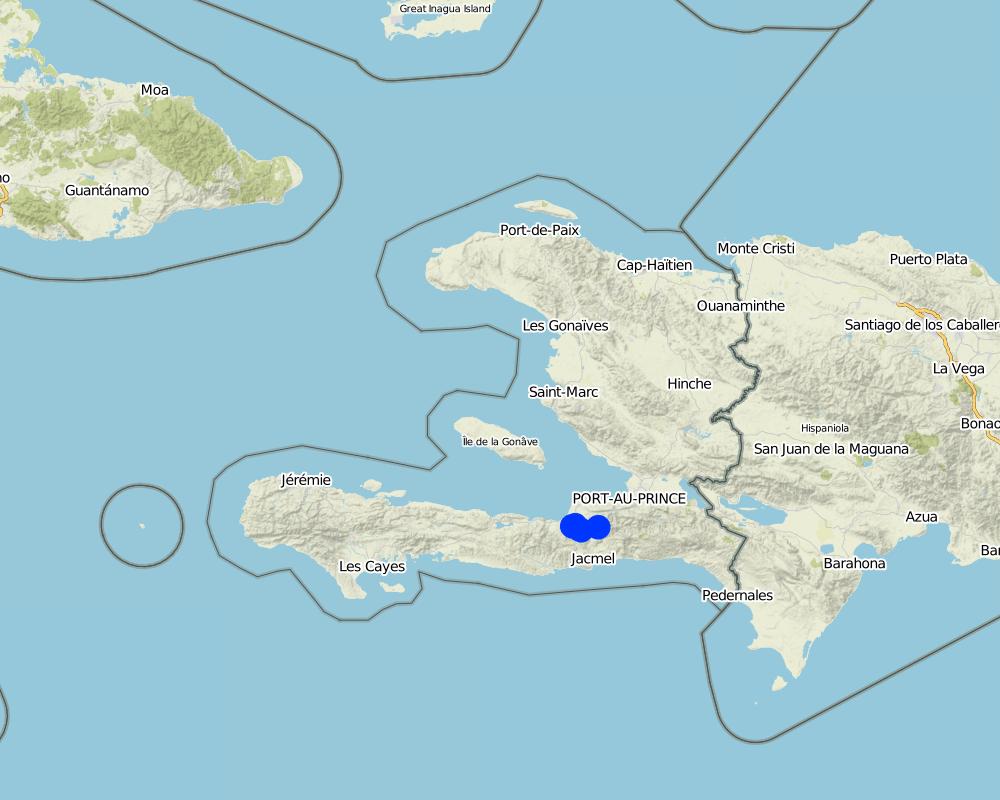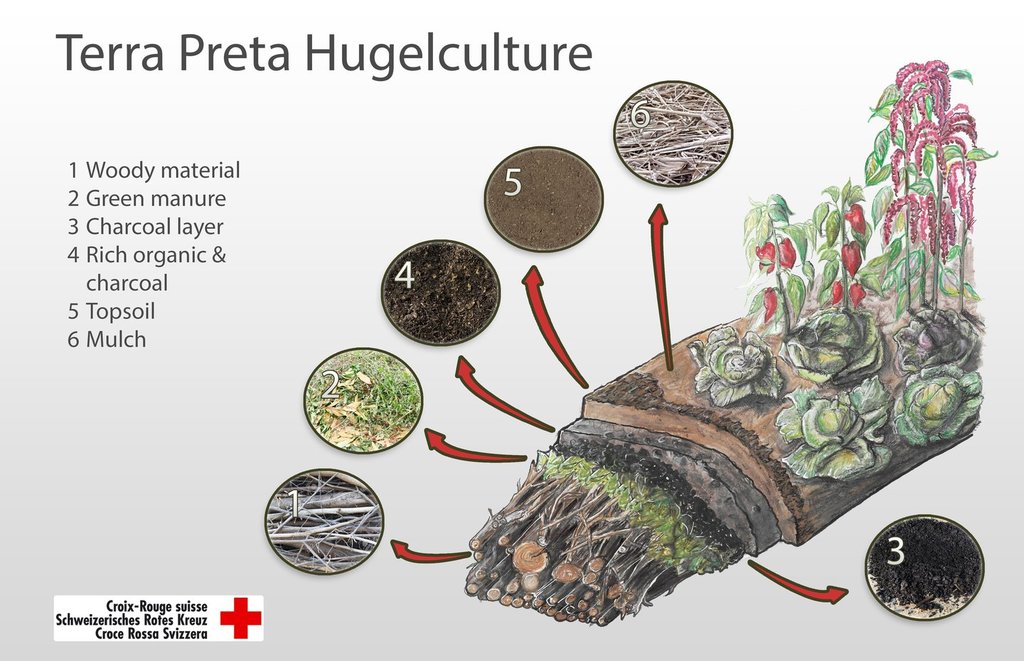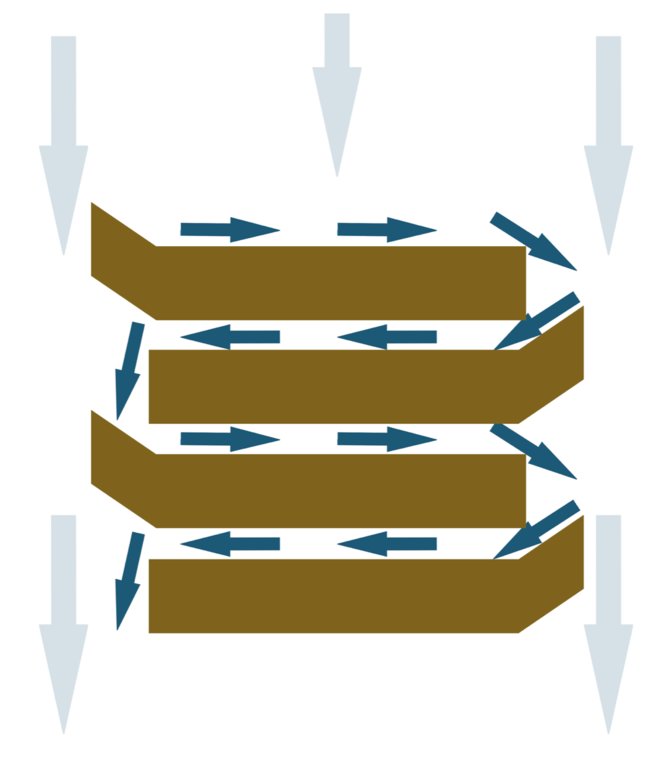Terra Preta raised garden beds [Haiti]
- Creation:
- Update:
- Compiler: Karl Harald Bier
- Editor: Anton Jöhr
- Reviewers: David Beritault, Alexandra Gavilano
Jaden kolin, Tè mirak
technologies_935 - Haiti
View sections
Expand all Collapse all1. General information
1.2 Contact details of resource persons and institutions involved in the assessment and documentation of the Technology
Name of project which facilitated the documentation/ evaluation of the Technology (if relevant)
Book project: where people and their land are safer - A Compendium of Good Practices in Disaster Risk Reduction (DRR) (where people and their land are safer)Name of the institution(s) which facilitated the documentation/ evaluation of the Technology (if relevant)
Swiss Red Cross (Swiss Red Cross) - Switzerland1.3 Conditions regarding the use of data documented through WOCAT
When were the data compiled (in the field)?
08/12/2016
The compiler and key resource person(s) accept the conditions regarding the use of data documented through WOCAT:
Yes
1.4 Declaration on sustainability of the described Technology
Is the Technology described here problematic with regard to land degradation, so that it cannot be declared a sustainable land management technology?
No
1.5 Reference to Questionnaire(s) on SLM Approaches
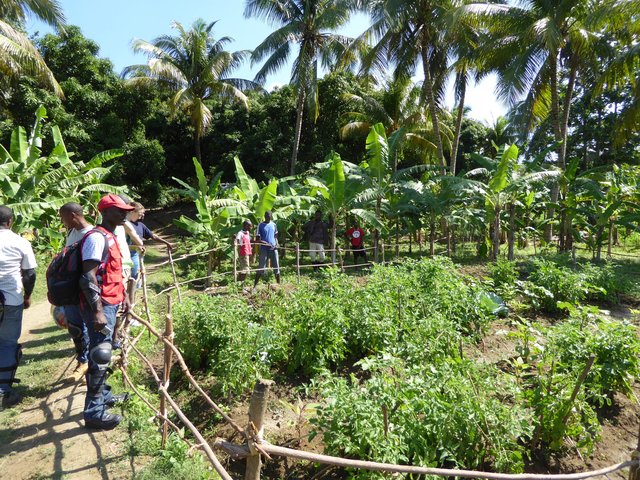
Approach at household level for Terra Preta home … [Haiti]
The approach of the Terra Preta home gardens at household level, with demonstration gardens created with members of grass-roots community organizations (GCO), facilitates the extension of the Terra Preta technology among the vulnerable population in the rural zones of the municipality of Léogâne, Haiti.
- Compiler: Helen Gambon
2. Description of the SLM Technology
2.1 Short description of the Technology
Definition of the Technology:
Terra Preta raised garden beds are a combination of techniques from permaculture and the production of Terra Preta, an anthrosol. These garden beds, which were created with local resources, are highly fertile and enable the production of much higher yields than traditional techniques, while diminishing soil erosion.
2.2 Detailed description of the Technology
Description:
One of the major problems in the mountainous rural zones of the municipality of Léogâne in Haiti is the severe degradation and erosion of soils. The soil loss aggravates the vulnerable situation of the local population, mainly farmers. The Terra Preta raised garden beds were introduced in this region after the earthquake of 2010, and were replicated by several organisations and also by members of the communities. They are based on two main techniques:
1) Terra Preta is a technique to create soils based on a lacto-acidic fermentation of organic matter with charcoal powder. This technique was used by indigenous people in Amazonia, and rediscovered and replicated recently by scientists. The technique is characterised by the use of local resources and a high fertility. With this technique, a soil layer of several decimeters can be produced in a few years, whereas this takes normally around 100 years per centimeter. Soil analyses show that the formation of humic acids can be demonstrated after 4 months.
2) Raised garden beds (Hugelculture) are a technique from permaculture. Permaculture is a science of agricultural and social systems which uses the principles of ecology and the knowledge of traditional societies to simulate the diversity, stability and the resilience of natural ecosystems. Raised garden beds consist of an interior of ligneous material, covered by a layer of earth. The elevated construction facilitates the work in the garden and the decomposition of wood inside the beds. Due to their spongy structure, the raised garden beds function as a water reservoir during dry periods.
The garden beds are placed perpendicularly to the slope direction as much as possible, and are arranged alternately, with an extension to redirect the surface runoff towards the structures. This arrangement prevents the water from draining directly. This promotes the infiltration of water into the soil, where it is captured by the ligneous material, which prevents erosion (see the photograph).
The following inputs to the garden beds can be found locally:
- Organic matter: ligneous material, dry straw, fresh straw, harvest residues, organic residues rich in NPK (kitchen waste, animal waste, etc.),
- Charcoal powder (biochar),
- Possibly ashes or other fertile materials.
With these materials, which are generally without cost and locally available, a raised garden bed can be set up in less than an hour. Even without additional fertilisation after the set up, the technique offers the possibility to have several cycles of vegetable production. Experiments showed good results during 4 years of continuous plantation in Thozin (Grand Goâve). In order to secure soil fertility for many years, organic matter can be added after the period of plantation. It can be easily incorporated below the first layer of soil, and the decomposition takes place automatically. When put in place on sloping terrain, the garden beds slow down erosion strongly, and can serve to protect houses.
The technique is valued because of its cost-effectiveness and its sustainability compared to known techniques. The complexity of the implementation can be a limiting factor for an autonomous replication by the beneficiaries. That is when they see the set-up of the structures and think they know how to replicate it without taking account of all the details which are essential for the good functioning of the structures. This is why generally a certain level of support by technicians is required.
2.3 Photos of the Technology
2.5 Country/ region/ locations where the Technology has been applied and which are covered by this assessment
Country:
Haiti
Region/ State/ Province:
West department
Further specification of location:
Municipality of Léogâne
Map
×2.6 Date of implementation
If precise year is not known, indicate approximate date:
- less than 10 years ago (recently)
2.7 Introduction of the Technology
Specify how the Technology was introduced:
- through projects/ external interventions
3. Classification of the SLM Technology
3.1 Main purpose(s) of the Technology
- improve production
- reduce, prevent, restore land degradation
- reduce risk of disasters
- mitigate climate change and its impacts
- create beneficial economic impact
- create beneficial social impact
3.2 Current land use type(s) where the Technology is applied

Cropland
- Annual cropping
Main crops (cash and food crops):
Vegetables (for example pepper, cabbage, spinach, tomato, chili pepper)
Comments:
With this technique, marginal land can be cultivated. The soil in place does not play a very important role because the nutrients are contained in the inputs.
If land use has changed due to the implementation of the Technology, indicate land use before implementation of the Technology:
The technology enables the production of vegetables on land that was not productive before (degraded soils, sandy or inert substrates). This allows farmers to diversify their traditional crops of maize, peas, sorghum and sweet potato with vegetables.
3.3 Further information about land use
Water supply for the land on which the Technology is applied:
- rainfed
Number of growing seasons per year:
- 2
Specify:
The intervention zone has 2 cropping periods based on 2 rainy seasons. The Terra Preta raised garden beds are usually used all year round.
3.4 SLM group to which the Technology belongs
- integrated soil fertility management
- cross-slope measure
- home gardens
3.5 Spread of the Technology
Specify the spread of the Technology:
- applied at specific points/ concentrated on a small area
3.6 SLM measures comprising the Technology

agronomic measures
- A2: Organic matter/ soil fertility
- A3: Soil surface treatment

structural measures
- S2: Bunds, banks
3.7 Main types of land degradation addressed by the Technology

soil erosion by water
- Wt: loss of topsoil/ surface erosion
- Wg: gully erosion/ gullying

biological degradation
- Bl: loss of soil life
3.8 Prevention, reduction, or restoration of land degradation
Specify the goal of the Technology with regard to land degradation:
- reduce land degradation
- restore/ rehabilitate severely degraded land
4. Technical specifications, implementation activities, inputs, and costs
4.1 Technical drawing of the Technology
4.2 Technical specifications/ explanations of technical drawing
1. Terrain analysis:
The first step in the construction is the terrain analysis: what is the size of the terrain, the relief, the environment (vegetation, buildings, water courses) and which are the resources (water, biochar, vegetation, animals, organic residues) present in place? Specific needs and social aspects, the neighbourhood and land holdings must also be considered.
2. Elaborating a land use plan:
The second step is the elaboration of a land use plan: definition of the position of the garden beds, of the protection measures (against wind, sun and heat), and of the vegetables to grow.
3. Construction of the garden beds:
After the preparatory work, the actual construction of the garden beds begins.
- A trench of approximately 10 cm depth is dug (width of 1-1.20 m, length undefined),
- The ligneous materials (decomposing wood, of larger or smaller volume) are arranged to create a mound. Holes between the materials should be filled-up with earth.
- The organic matter is added in layers in the following order: dry straw, animal waste, pulse crops and organic matter rich in NPK.
- Charcoal powder can be added between the layers of rich organic matter, or even better, mixed with the latter.
- A layer of earth of approximately 10 cm is added as cover.
- During the process of construction, every layer should be watered.
The establishment of multiple garden beds is done as described in figure 2 above. The garden beds are installed in alternation with an extension to redirect the surface runoff towards the structures. The water is forced around the structures, which will facilitate the infiltration of the water and the deposition of sediments. As a result, the water is captured in the garden bed, and erosion is reduced. A more detailed description with illustrations is given below.
4.3 General information regarding the calculation of inputs and costs
Specify how costs and inputs were calculated:
- per Technology unit
Specify unit:
isolated structure
Specify volume, length, etc. (if relevant):
width: 1.10 m; length: 10 m
other/ national currency (specify):
Haiti Gourde
Indicate exchange rate from USD to local currency (if relevant): 1 USD =:
68.0
Indicate average wage cost of hired labour per day:
250
4.4 Establishment activities
| Activity | Type of measure | Timing | |
|---|---|---|---|
| 1. | Outlining of raised garden beds | Other measures | year-round |
| 2. | Collection of materials | Other measures | year-round |
| 3. | Digging a basin along the contour | Structural | year-round, preferably at the start of the rainy season |
| 4. | Building the different layers (wood, dry straw, fresh straw, pulse crops and organic matter rich in NPK, earth, charcoal powder) | Structural | year-round, preferably at the start of the rainy season |
| 5. | Replanting of vegetable seedlings | Agronomic | year-round, preferably at the start of the rainy season |
| 6. | Watering | Agronomic | year-round, preferably at the start of the rainy season |
4.5 Costs and inputs needed for establishment
| Specify input | Unit | Quantity | Costs per Unit | Total costs per input | % of costs borne by land users | |
|---|---|---|---|---|---|---|
| Labour | Skilled labour (technical support) | person-days | 0.5 | 3000.0 | 1500.0 | |
| Labour | Unskilled labour (construction) | person-days | 1.0 | 250.0 | 250.0 | 100.0 |
| Equipment | Tools (spade, pickaxe) | piece | 1.0 | 5.0 | 5.0 | 100.0 |
| Plant material | Seedlings of cabbage | seedling | 10.0 | 10.0 | 100.0 | |
| Plant material | Seedlings of spinach | seedling | 20.0 | 5.0 | 100.0 | |
| Plant material | Seedlings of tomato | seedling | 10.0 | 5.0 | 50.0 | |
| Construction material | Decomposing wood | batch | 1.0 | 200.0 | 200.0 | 100.0 |
| Construction material | Earth | batch | 1.0 | 50.0 | 50.0 | 100.0 |
| Construction material | Dry straw | batch | 1.0 | 100.0 | 100.0 | 100.0 |
| Construction material | Fresh straw | batch | 1.0 | 100.0 | 100.0 | 100.0 |
| Construction material | Animal waste | Bag | 1.0 | 100.0 | 100.0 | 100.0 |
| Construction material | Charcoal/biochar | kg | 50.0 | 2.0 | 100.0 | 100.0 |
| Total costs for establishment of the Technology | 2655.0 | |||||
If land user bore less than 100% of costs, indicate who covered the remaining costs:
Swiss Red Cross
Comments:
The land users have the necessary tools (5 HTG are budgeted to compensate for the use of their own tools). The construction materials are also locally available, and are generally considered as waste.
4.6 Maintenance/ recurrent activities
| Activity | Type of measure | Timing/ frequency | |
|---|---|---|---|
| 1. | watering | Agronomic | 3 days |
| 2. | weeding | Agronomic | 2 weeks |
| 3. | mulching | Agronomic | 2 months |
| 4. | refertilisation | Agronomic | 5 years |
4.7 Costs and inputs needed for maintenance/ recurrent activities (per year)
| Specify input | Unit | Quantity | Costs per Unit | Total costs per input | % of costs borne by land users | |
|---|---|---|---|---|---|---|
| Labour | Annual maintenance | person-days | 15.0 | 250.0 | 3750.0 | 100.0 |
| Equipment | Watering device | piece | 1.0 | 150.0 | 150.0 | 100.0 |
| Plant material | Seed and seedlings | various | 1.0 | 250.0 | 250.0 | 100.0 |
| Total costs for maintenance of the Technology | 4150.0 | |||||
Comments:
The indicated costs for the seed and the seedlings are the costs on the local market, but the land users reproduce these from existing plants, that they received from the project for the first implemented raised bed.
4.8 Most important factors affecting the costs
Describe the most determinate factors affecting the costs:
The labour (and the technical support for the first 3-4 structures of raised beds).
5. Natural and human environment
5.1 Climate
Annual rainfall
- < 250 mm
- 251-500 mm
- 501-750 mm
- 751-1,000 mm
- 1,001-1,500 mm
- 1,501-2,000 mm
- 2,001-3,000 mm
- 3,001-4,000 mm
- > 4,000 mm
Specifications/ comments on rainfall:
There is a dry season from December to February and a rainy season from April to October, with two peaks at the start and at the end of the period, and a relative pause in July.
Agro-climatic zone
- sub-humid
5.2 Topography
Slopes on average:
- flat (0-2%)
- gentle (3-5%)
- moderate (6-10%)
- rolling (11-15%)
- hilly (16-30%)
- steep (31-60%)
- very steep (>60%)
Landforms:
- plateau/plains
- ridges
- mountain slopes
- hill slopes
- footslopes
- valley floors
Altitudinal zone:
- 0-100 m a.s.l.
- 101-500 m a.s.l.
- 501-1,000 m a.s.l.
- 1,001-1,500 m a.s.l.
- 1,501-2,000 m a.s.l.
- 2,001-2,500 m a.s.l.
- 2,501-3,000 m a.s.l.
- 3,001-4,000 m a.s.l.
- > 4,000 m a.s.l.
Indicate if the Technology is specifically applied in:
- not relevant
5.3 Soils
Soil depth on average:
- very shallow (0-20 cm)
- shallow (21-50 cm)
- moderately deep (51-80 cm)
- deep (81-120 cm)
- very deep (> 120 cm)
Soil texture (topsoil):
- medium (loamy, silty)
- fine/ heavy (clay)
Soil texture (> 20 cm below surface):
- coarse/ light (sandy)
Topsoil organic matter:
- low (<1%)
5.4 Water availability and quality
Ground water table:
> 50 m
Availability of surface water:
medium
Water quality (untreated):
poor drinking water (treatment required)
Is water salinity a problem?
No
Is flooding of the area occurring?
No
5.5 Biodiversity
Species diversity:
- medium
Habitat diversity:
- low
5.6 Characteristics of land users applying the Technology
Sedentary or nomadic:
- Sedentary
Market orientation of production system:
- subsistence (self-supply)
Off-farm income:
- less than 10% of all income
Relative level of wealth:
- very poor
Individuals or groups:
- individual/ household
Level of mechanization:
- manual work
Gender:
- women
- men
Age of land users:
- middle-aged
- elderly
5.7 Average area of land owned or leased by land users applying the Technology
- < 0.5 ha
- 0.5-1 ha
- 1-2 ha
- 2-5 ha
- 5-15 ha
- 15-50 ha
- 50-100 ha
- 100-500 ha
- 500-1,000 ha
- 1,000-10,000 ha
- > 10,000 ha
Is this considered small-, medium- or large-scale (referring to local context)?
- small-scale
5.8 Land ownership, land use rights, and water use rights
Land ownership:
- individual, not titled
- individual, titled
Land use rights:
- individual
Water use rights:
- open access (unorganized)
- individual
5.9 Access to services and infrastructure
health:
- poor
- moderate
- good
education:
- poor
- moderate
- good
technical assistance:
- poor
- moderate
- good
employment (e.g. off-farm):
- poor
- moderate
- good
markets:
- poor
- moderate
- good
energy:
- poor
- moderate
- good
roads and transport:
- poor
- moderate
- good
drinking water and sanitation:
- poor
- moderate
- good
financial services:
- poor
- moderate
- good
6. Impacts and concluding statements
6.1 On-site impacts the Technology has shown
Socio-economic impacts
Production
crop production
Quantity after SLM:
an increase of yields by 2-3 times
Comments/ specify:
The yield usually increases 2-3 times with the introduction of the technique.
crop quality
Comments/ specify:
The crops are more healthy and more resistant to diseases. The quality of the vegetables is better, and clients on the market of Grand Goâve pay more for the products from Terra Preta.
product diversity
Comments/ specify:
The majority of persons in the area are not used to vegetable growing. The technique makes it possible to grow vegetables which increase the nutritional basis (rice, pearl millet, sweet potato and peas).
production area
Comments/ specify:
Normally, the soils are not used for crop production. Through the technique production area is created. In addition, the surface increases through the undulated shape of the garden beds.
Ecological impacts
Water cycle/ runoff
water quantity
Comments/ specify:
a) The infiltration of water in the soil is facilitated.
b) The water is retained by the organic matter in the garden beds (especially by the decomposing wood).
surface runoff
Soil
soil moisture
soil accumulation
Comments/ specify:
Water erosion is slowed down by the garden beds, and the sediments are deposited in front of these. However, the size of the garden beds is limited, and in order to combat erosion on a larger scale additional measures must be considered, like vegetated barriers or terracing.
soil compaction
soil organic matter/ below ground C
Comments/ specify:
Soil analyses
sample 1: 0.93%- >3.50%
sample 2: 2.04% - >5.51%
Climate and disaster risk reduction
drought impacts
Comments/ specify:
In the dry periods, the technique permits to continue crop production during several weeks without irrigation.
emission of carbon and greenhouse gases
Comments/ specify:
Sequestered in the soil by the charcoal and the organic matter (especially the ligneous material).
6.2 Off-site impacts the Technology has shown
water availability
damage on public/ private infrastructure
6.3 Exposure and sensitivity of the Technology to gradual climate change and climate-related extremes/ disasters (as perceived by land users)
Climate-related extremes (disasters)
Meteorological disasters
| How does the Technology cope with it? | |
|---|---|
| tropical storm | moderately |
| local rainstorm | very well |
| local thunderstorm | well |
6.4 Cost-benefit analysis
How do the benefits compare with the establishment costs (from land users’ perspective)?
Short-term returns:
very positive
Long-term returns:
very positive
How do the benefits compare with the maintenance/ recurrent costs (from land users' perspective)?
Short-term returns:
very positive
Long-term returns:
very positive
6.5 Adoption of the Technology
- 1-10%
If available, quantify (no. of households and/ or area covered):
>300 households
Of all those who have adopted the Technology, how many have did so spontaneously, i.e. without receiving any material incentives/ payments?
- 50-90%
Comments:
Small quantities of seed were given.
6.6 Adaptation
Has the Technology been modified recently to adapt to changing conditions?
No
6.7 Strengths/ advantages/ opportunities of the Technology
| Strengths/ advantages/ opportunities in the land user’s view |
|---|
|
Strongly increased yield |
| Improved product quality (size, taste) |
| Shortened crop cycle |
| Strengths/ advantages/ opportunities in the compiler’s or other key resource person’s view |
|---|
| Increased production (several times) |
| Improved nutrition |
| Income generation for the farmers |
| Shortened production cycle |
6.8 Weaknesses/ disadvantages/ risks of the Technology and ways of overcoming them
| Weaknesses/ disadvantages/ risks in the land user’s view | How can they be overcome? |
|---|---|
| More work than traditional techniques. The latter are focused on agricultural production in fields (maize, pearl millet, sweet potato, peas/beans), and require considerably less daily maintenance. | By having the gardens close to the house for follow-up and support. |
| Weaknesses/ disadvantages/ risks in the compiler’s or other key resource person’s view | How can they be overcome? |
|---|---|
| Complexity of the technique | Regular education, follow-up and continuous support |
7. References and links
7.1 Methods/ sources of information
- field visits, field surveys
80
- interviews with land users
30
- interviews with SLM specialists/ experts
D. Buchon, external consultant
7.2 References to available publications
Title, author, year, ISBN:
Terra Preta: Production. Guide des méthodes de la production de Terra Preta dans les jardins potagères. Karl Harald Bier. 2013.
Available from where? Costs?
Welthungerhilfe
Title, author, year, ISBN:
Pas de la mise en place d'un Jardin Colline TP. Karl Harald Bier. Swiss Red Cross
Available from where? Costs?
info@redcross.ch
7.3 Links to relevant information which is available online
Title/ description:
Terra Preta - Charbon bio - Climatefarming, Hans-Peter Schmidt, 2008, ISSN 1663-0521
URL:
http://www.ithaka-journal.net/climatefarming-fr1?lang=fr
Links and modules
Expand all Collapse allLinks

Approach at household level for Terra Preta home … [Haiti]
The approach of the Terra Preta home gardens at household level, with demonstration gardens created with members of grass-roots community organizations (GCO), facilitates the extension of the Terra Preta technology among the vulnerable population in the rural zones of the municipality of Léogâne, Haiti.
- Compiler: Helen Gambon
Modules
No modules



